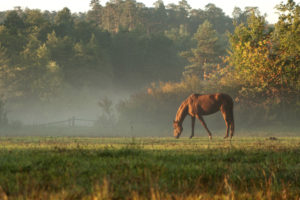Fall Pasture Management

Fall presents an excellent opportunity for horse owners to improve the quality of their pastures. By focusing on seeding or overseeding, weed control, fence maintenance, and grazing practices, horse owners can ensure healthier and more productive pastures during the fall season.
Seeding and Overseeding: Optimal Time and Benefits
Between August 1st and September 15th, horse owners should consider seeding or overseeding their pastures. This period offers favorable conditions, including adequate moisture, reduced weed competition, and cooler weather. Seeding or re-seeding during the fall allows for better establishment and growth of desired grasses, leading to improved pasture quality.
Perennial Weed Control: Best Time and Effectiveness
Fall is the preferred time for addressing perennial weeds in pastures. Perennial plants store carbohydrates in their roots during this season, making them more susceptible to herbicides. Treating weeds in the fall allows the herbicide to be translocated to the root, ensuring more effective control and reducing competition for nutrients in the pasture.
Fence Maintenance: Importance and Timely Repairs
Prior to the ground freezing, it is crucial to inspect and repair fences, especially posts. Broken posts should be fixed promptly to prevent further damage. By addressing fence issues before winter, horse owners can ensure the safety and containment of their horses.
Preparing for Winter:
Re-Growth and Winter Survival
Before winter sets in, it is essential to allow pasture grasses to have 3 to 4 inches of re-growth. This re-growth contributes to their winter survival and promotes quicker spring growth. Providing sufficient growth going into winter supports the overall health and resilience of the pasture.
Utilizing Sacrifice Paddocks
Instead of keeping horses on pastures during winter, it is recommended to use sacrifice paddocks or dry lots. These areas offer shelter, access to hay, and water while minimizing damage to the pasture. Grazing on pastures over winter provides limited nutrition to horses and can harm the plants.
Grazing After the First Killing Frost: Potential Risks and Caution
After the first killing frost of fall, horse owners should exercise caution when grazing. Frost-damaged pasture forages tend to have higher concentrations of non-structural carbohydrates. This can increase the risk of laminitis and colic, particularly for obese horses or those diagnosed with laminitis and equine metabolic syndrome. To reduce the chances of adverse health effects, it is advisable to wait for one week after the first killing frost before turning all horses, including healthy ones, back onto the pasture.
Promoting Healthy Pastures and Horse Well-being
By implementing effective fall pasture management practices, horse owners can enhance the quality of their pastures and support the overall health of their horses. Seeding or overseeding, controlling perennial weeds, maintaining fences, and making prudent grazing decisions contribute to healthier pastures during fall and beyond. With proper management, horse owners can ensure optimal nutrition, winter survival, and a thriving pasture for their equine companions.
Ready to ensure your horse is getting the optimum nutrition at feeding time, every time? Find the perfect feed formulated specifically for horse’s needs with our Feed Selector Tool.
This article is reprinted with permission from Krishona Martinson, University of Minnesota.
